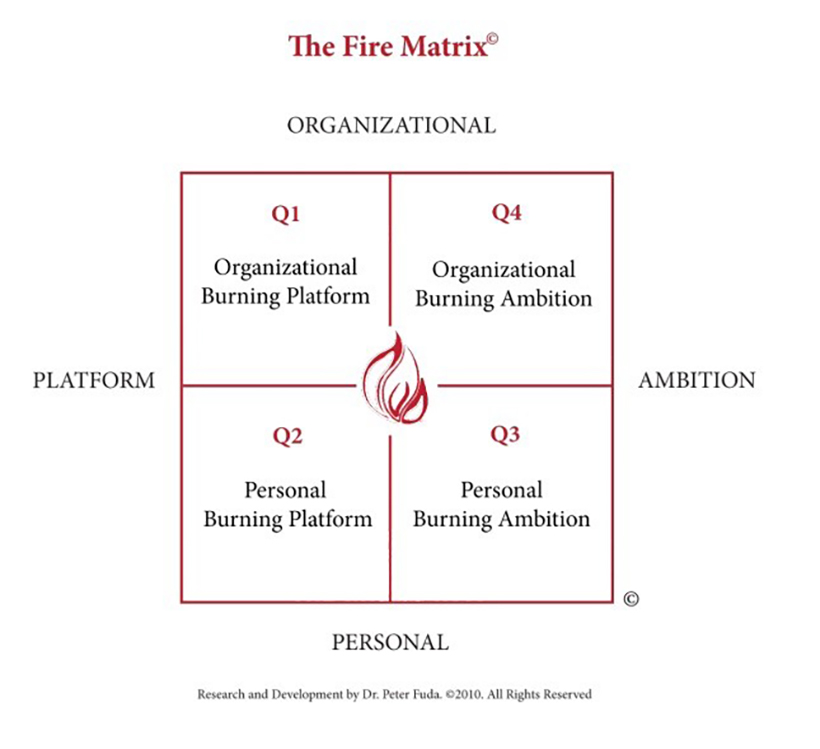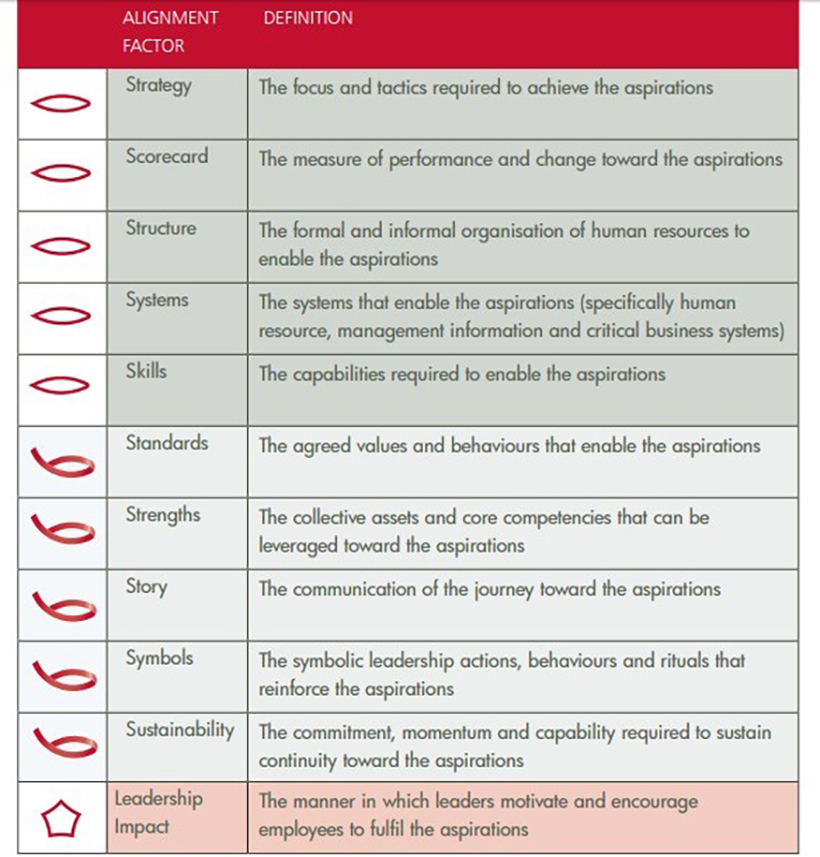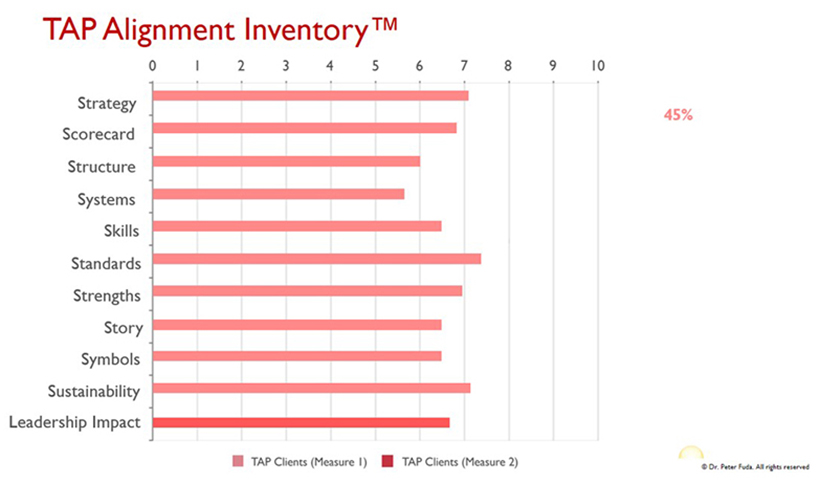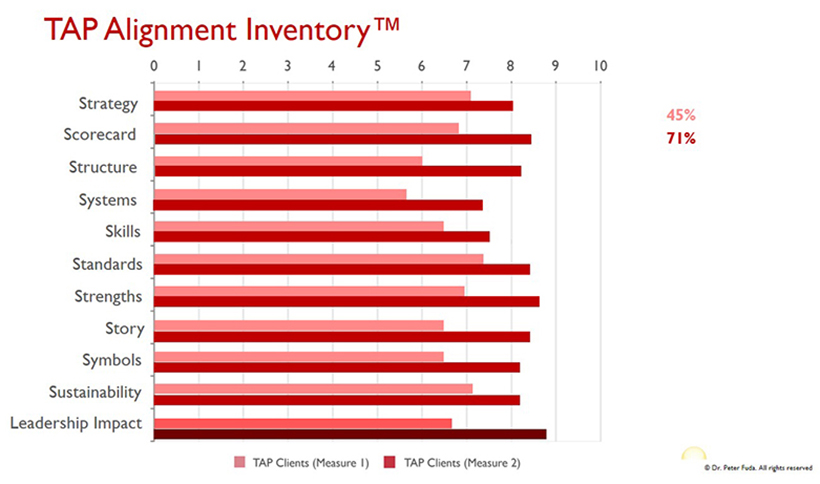Change Champs & Change Chumps: A Story of Leaders, Burning Ambition, and Alignment
By: Peter Fuda and Brad Winn
“If doctors practiced medicine the way many companies practice management, there would be far more sick and dead patients, and many more doctors would be in jail.” Most organizational transformation efforts fail. This is because our ‘change management’ strategies are outdated and misguided. Change for the sake of change is not the goal. The goal is the goal.
Leaders understand the need to spark and sustain change, but to what end? When we talk about “change” or worse a “change program,” what people hear is pain, loss, extra effort, increased risk, and greater uncertainty. The simplest way to increase our odds of success is to stop talking about change and start talking about our ambitions. Paint a rich picture of what success looks like. Then move away from a focus on change toward aligning everything and everyone with these ambitions. This is the first step in overcoming the gap between where we are and where we want to be.
As noted in the Call for Papers, “Top leaders own the accountability to align organization design, leadership, talent, and culture with a new or refocused business strategy and take the actions required for transformation.” Responding to this call, this article summarizes fifteen years of research and practice in helping executives align their organizations to their ambitions and overcoming the typical ‘change management’ failures. The approaches outlined in this paper were developed by Dr. Peter Fuda, a thought leader in business transformation, professor of management, and founding principal of The Alignment Partnership (TAP).
From Burning Platform to Burning Ambition
The metaphor of the burning platform is perhaps one of the most pervasive in business. It comes from the true story of Andy Mochan, a worker on the Piper Alpha oil rig when it exploded in July 1988, killing 167 of his colleagues.
In the story, Mochan is awoken by the explosion. He runs up on deck to see that the platform is on fire. He is now faced with a choice; does he stay on the platform and burn alive, or does he jump more than 150 feet into freezing water? As the flames engulf the platform, he makes the split-second decision to jump. Somehow, he survives the impact and is rescued by a boat before freezing to death. When asked why he jumped he replies “better probable death than certain death.”
This is an amazing story of survival amid tragedy, but it’s not particularly helpful for leadership or business transformation. It implies that fear and extreme urgency are not only necessary, but somehow desirable motivators for change; the implication being that in order to change, we all need to have our pants on fire.
We use the ‘fire’ metaphor to describe the motivational forces that start and sustain a transformation effort. Research has shown that this motivation is a dance around four quadrants (see Figure 1).

Quadrant 1: Organizational Burning Platform
Typically, leaders are readily able to list the problems and issues that have motivated them to undertake a transformation effort. Time after time, we hear statements like “Our financial trajectory is poor,” “Our competitors are more aggressive,” “Our customers are squeezing us,” or “Our staff engagement is at an all-time low.”
The burning platform is pervasive. Leaders often operate from the belief that nothing significant happens without a crisis. However, this quadrant often hides a deeper set of fears and issues.
Quadrant 2: Personal Burning Platform
As executives continue on their quest for more effective leadership, they gradually begin to open up about their personal fears, challenges, and insecurities. For example, they say things such as, “My reputation is on the line—I’ll look really stupid if I can’t build a company of substance,” or “Every day I try out a different approach, but nothing seems to work,” or “I’m physically exhausted; I can’t keep going like this.”
This more personal motivation for change is often concealed beneath more obvious organizational forces. In an attempt to live up to pervasive notions of the “heroic leader” and avoid looking weak, senior executives will bury or otherwise disguise their personal motivations for engaging in a transformation effort. Understanding one’s personal fears allows leaders to shift quickly away from hiding what they fear most and move toward realizing their deepest personal ambitions.
Quadrant 3: Personal Burning Ambition
It is in the third quadrant, the personal burning ambition, where leaders find commitment. Personal accountability for change then really begins to accelerate. Quadrants 1 and 2 are about running from a fire; quadrant 3 describes a fire that burns inside.
The motivation behind a personal burning ambition is evident in statements like “I want to live a big and authentic life,” “I want to increase my health and happiness,” “I want to align my work with a strong sense of purpose and meaning,” or “I want to fulfill my leadership potential.” When leaders shift their focus away from what they want to avoid toward what they want to achieve, they experience a dramatic shift in energy. They move away from insecurity and perennial urgency toward a calmer and more purposeful disposition. This enables them to apply a more deliberate and disciplined effort toward realizing those ambitions.
Quadrant 4: Organizational Burning Ambition
Leaders’ personal ambitions are surpassed by the lasting impact they wish to have on their organizations, their customers, their industries, and their communities. Leaders saying things like, “I want to leave a legacy of a growing organization,” “I want my successor to be set up for even greater success,” “I want to transform our industry,” or “I want to revolutionize the customer experience,” are all expressions of the motivational forces at play in this quadrant.
Burning ambitions provide far greater leverage than burning platforms to keep leaders on track. Leaders face days when it just feels too hard, where they encounter opposition, or where they are consumed by short-term pressures that demand immediate attention. Clarity of personal and organizational ambition allows leaders to reorient their focus in spite of these competing pressures, and allows them to accept short-term pain in the pursuit of longer-term gain.
To sustain a transformation journey, shifting from a burning platform to a burning ambition is absolutely critical. Why? Because this shift allows leaders to become calmer, more purposeful, and more responsive to the inevitable challenges they are going to face. Secondly, it is not only vital for a leader to articulate the organizational reasons for change, but they actually need to delve deeper and establish very compelling personal motivations for change. Finally, the fire or the ‘Big Why’ is actually a crucial part of how leaders transform. As Nietzsche said, "he who has a why to live can bear almost any how."
Moving from a burning platform to a burning ambition is a necessary first step toward organizational transformation. Yet while ambition and intention are absolutely necessary, these alone are not sufficient.
Transformation is Not Just a Matter of Intention; It’s a Matter of Alignment
Leaders begin with noble intentions. In fact, we have never met a leader who aspires to destroy shareholder value, irritate customers, and alienate staff. Yet often the unintended consequence of our leadership is to do just that.
We all have aspirations for our organizations. The real challenge is that we often do not properly scrutinize them. Specifically, is every single person in the organization clear on what success looks like? Are the aspirations compelling? Do we actually have the capability to get there? Do we have the bandwidth? Are we all confident we can get there? Are we all truly committed to this aspiration? Are we clear on our personal contribution?
The ‘7C’ model shows how all of the leaders surveyed in this research, in aggregate, have rated their aspirations against seven key dimensions. It turns out that they are extraordinarily committed; they are just not sure exactly what they are committed to, how they are going to get there, or what their personal contribution is!

Once we uncover the gaps, we have the potential to address them. For example, a multinational financial services organization had aspired to 40% market share for some time without making any real inroads from its then current state of 28%. After taking the 7C Test, the recently appointed CEO discovered that his people were clear about the goal and were committed to its achievement. The leadership team also felt that they possessed the capability and were relatively confident. The key challenge was that they lacked capacity due to competing pressures for resources and conflicting goals emanating from the corporate parent.
Instead of wasting precious time reinventing the organization’s ultimate aspiration, the CEO invested all of his focus in aligning the organization’s scarce resources, and obtaining buy-in from corporate headquarters focused on the goal. This approach ensured the organization was reenergized around the aspiration, rather than disenfranchised by yet another vision statement. Three years into the journey, the organization went on to surpass its aspiration – ultimately reaching 50% market share.
Alignment is a Multi-Lever, Multi-Layer Process
Transformation may be closer than we think. We mistakenly search for the one big thing that will create success. Success comes from the aggregation of marginal gains. It comes from a making a large number of very small changes that collectively generate the momentum we need.
Based on in depth work with dozens of companies on four continents over 15 years, we have found 11 levers that leaders can pull to align their organizations to their aspirations (see model below). The more levers we pull at the same time, the more momentum we create.

You may be familiar with the so-called ‘hard’ levers of strategy, scorecard, structure, systems and skills. However, there are also five so-called ‘soft’ levers that are critical for alignment including; standards, story, strengths, symbols and sustainability.
The ‘hard’ alignment levers are like the ‘bricks’ of alignment, while the ‘soft’ levers are like the ‘mortar’. The irony of the ‘hard’ and ‘soft’ labels is that the majority of leaders are very comfortable with strategy, scorecard or structure, but struggle with levers like standards, story or symbols.
The final lever, Leadership Impact, represents the foundation of the alignment approach. This research, documented in Leadership Transformed , has revealed that the impact of leaders is as important as the other ten factors combined. This creates an alignment equation is S10x L, where leadership is the accelerant or handbrake on all other alignment efforts.
Below is the first measure of alignment for all of the companies included in this research. It shows how aligned each of the eleven levers is to the respective company’s aspirations. As you can see, the average score for each is approximately 6.7 giving us an average alignment score of 45% (S6.7 x L6.7).

6.7 for each lever is not terrible, but it is mediocre. More importantly, how can we complain about the marketplace or head office when, nominally speaking, we leave 55% of potential value on the table with levers that we control?
Below is the ‘re-test’ data for the companies included in this research who, over time, have shown significant improvements across a range of metrics including financial performance, customer advocacy and employee commitment. As you can see, relatively small changes across each of the levers can add up to a significant impact overall.

End Notes
Rather than talk about “change” or worse, a “change program”, leaders need to articulate their ambitions. Change is not the goal. The goal is the goal.
Once we articulate our ambitions, we need to make sure that those we lead find them clear, compelling and can see their personal contribution. We also need to ensure they feel we have the capacity and capability to get there. Finally, we can ascertain and increase their level of confidence and commitment.
With robust ambitions in place, all efforts must be focused on aligning everything and everyone. Alignment is a multi-layer and multi-lever exercise where many small changes add up to a large impact. The 11 alignment levers, hard and soft, provide the fundamental leverage that leaders need to reach their ambitions and overcome the kind of change failure that has become commonplace in our organizations.
i Pfeffer, J. and Sutton, R. (2006). Evidence-based Management. Harvard Business Review, (84)1.
ii Fuda, P. & Badham R. (2011). Fire, snowball, mask, movie: How leaders spark and sustain change. Harvard Business Review, (89)11.
iii See http://www.tap.net.au/
iv For an alternative list see http://tompeters.com/2011/03/a-brief-history-of-the-7-s-mckinsey-7-s-model/
v Fuda, P. (2013). Leadership transformed: How ordinary managers become extraordinary leaders. Houghton Mifflin Harcourt Publishing Company. NY: NY


